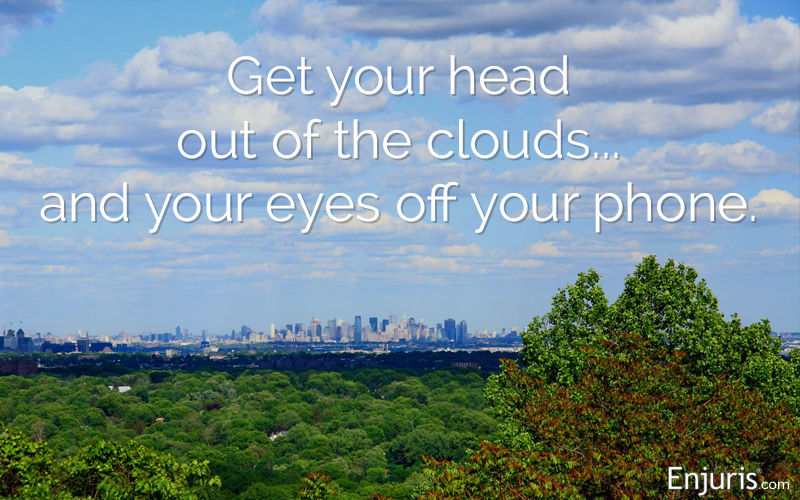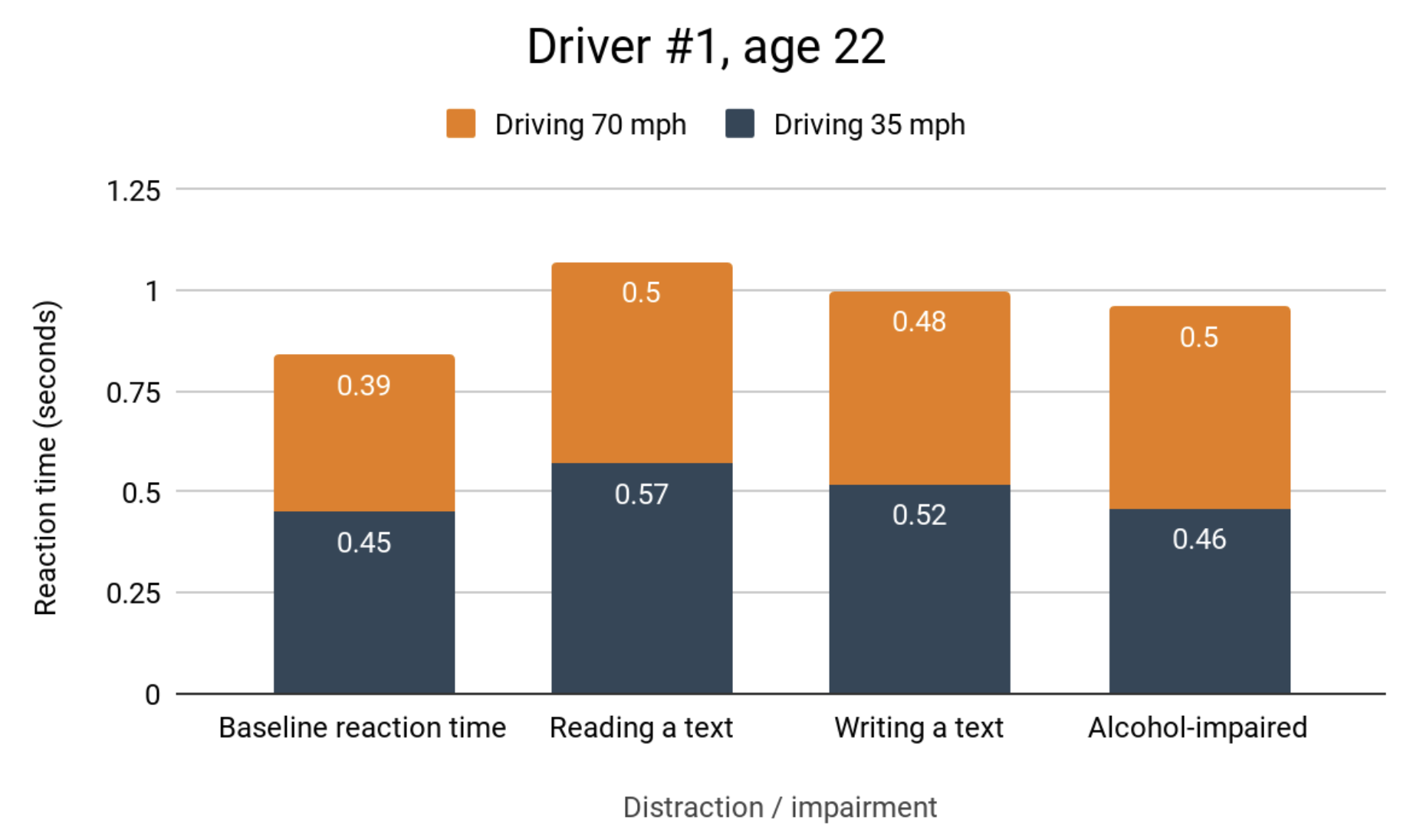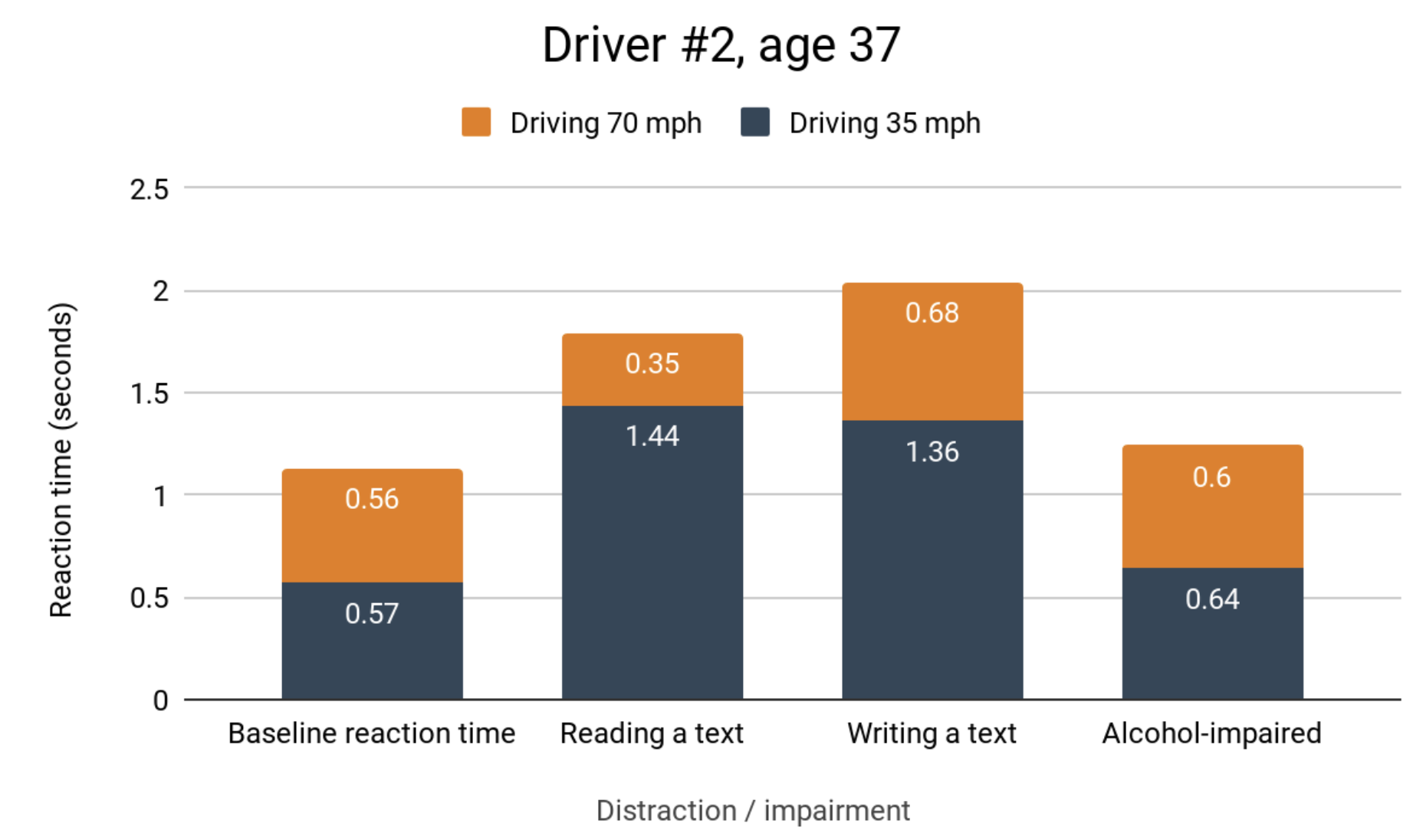
Distracted driving has become a big problem in the Garden State
By now you’re hopefully well aware of how dangerous drunk driving can be, thanks to many decades of increasing public awareness about the problem. Drunk driving was outlawed in New Jersey in 1906. However, it wasn’t until the 1970s and 1980s that law enforcement and government officials really began to crack down on intoxication offenses and sought to make the public aware of the dangers.
Today, we’re facing the problem of distracted driving.
There are many people out there who would never drink and drive because they’re aware of the dangers and they’re generally responsible, law-abiding citizens. Yet, those same people might think it’s fine to check a text, apply makeup in the rearview mirror, or reach for something on the floor of the back seat while driving. It’s not okay.
Distracted driving is as dangerous as drunk driving.
We know this because studies prove that a driver’s reaction time is lower when reading or writing a text than it is when impaired by alcohol. Researchers at Car and Driver performed a test to see how drivers’ reaction times were impacted by texting and driving, compared to drunk driving.
To perform the test, the car was fitted with a light mounted on the windshield that would simulate a car’s brake lights. The drivers were instructed to hit the brakes when the light went on. The test took place on an open runway with no obstacles, and the drivers were using typical phones.
Here’s what they found:


This data shows that both drivers’ reaction times were significantly slowed when texting (reading or writing) as compared to their baselines and reaction times while texting were higher than their reaction times when impaired by alcohol.
Although sometimes the differences are tenths or hundredths of a second, it’s significant because those hundredths of a second directly translate into the number of feet driven. So, for the additional 0.68 seconds of reaction time it took for one driver to write a text, his vehicle traveled 319 feet — which is practically the length of a football field.
Surprising distracted driving statistics
The National Highway Traffic Safety Administration reports that 400,000 people were injured in crashes involving distracted driving in 2018, and 2,841 were killed.
And those are just the ones we know about.
It can be hard to determine whether a crash was caused by distracted driving. When a driver is drunk, there are scientific ways to prove their blood alcohol content (BAC) like Breathalyzer testing at the scene. But unless there’s a witness, it could be impossible to know what a driver was doing at the time of a crash.
The New Jersey Department of Law & Public Safety reported that driver inattention was a major contributing factor in nearly 800,000 motor vehicle crashes from 2012 to 2016. The data also shows that “at any given daylight moment across America, approximately 416,000 drivers are using handheld cell phones.”
What is distracted driving?
Distracted driving is when a driver performs any activity while behind the wheel that takes their attention away from the primary task of driving.
There are 3 types of distraction:
- Visual: Anything that takes your eyes off the road.
- Manual: Anything that takes your hands off the wheel.
- Cognitive: Anything that takes your mind off the task of driving.
Distracted driving can include anything from eating or reaching for your coffee, to reaching into the backseat, applying makeup or shaving, looking in your mirror at your child in their car seat, playing loud music, or adjusting dashboard settings like climate control or sound.
Although each of these behaviors is distracting, using a cell phone is arguably the most dangerous (and most prevalent) form of distracted driving because it requires all 3 types of distraction at once — visual, manual, and cognitive.
New Jersey cell phone laws
Drivers are not allowed to talk or text with a hand-held device while driving in New Jersey. This includes talking, listening, sending, or receiving any electronic messaging.
A driver may use a handheld device while driving with a hand on the steering wheel only if:
- The driver believes their life or safety is in danger, or that they’re about to be the victim of a criminal act (or that one is being committed against another person)
- The driver is reporting a fire, crash, serious road hazard, medical or hazardous materials emergency, reckless driving, or a driver who appears to be under the influence of alcohol or drugs to authorities.
A driver who is under 21 years old may not use either a hand-held or hands-free device while driving in New Jersey.
New Jersey penalties for distracted driving
First offense: $200-$400 fine
Second offense: $400-$600 fine
Third or subsequent offense: $600-$800 fine, 3 motor vehicle points, possible 90-day license suspension
There will also be court costs in addition to these fines.
These are “primary offenses” under New Jersey law, which means you can be pulled over and ticketed for violating these laws even if you’re not committing any other infraction. If you’re driving while using a mobile device and injure another driver, passenger, pedestrian, or bicyclist, you could be charged with a crime or a felony.
If it’s a severe injury, you could face 6-18 months of jail time and up to a $10,000 fine. If the victim is killed, you could be charged with vehicular homicide. This would mean 5-10 years in jail and up to $150,000 in fines.
Distracted driving and personal injury lawsuits
If you were injured by someone who was driving while distracted, you might be able to sue for damages. Sometimes, that could include not only the driver but also the person who texted the driver, if they knew that the driver was behind the wheel at the time when the text was received.
Linda and David Kubert were seriously injured when their motorcycle, which David was driving and Linda was riding as a passenger, was hit by 18-year-old Kyle Best, who crossed the centerline of the roadway while driving his pick-up truck and texting. David’s leg was nearly severed and Linda’s left leg was shattered, with her fractured thigh bone protruding. Both David and Linda lost a leg as a result of the accident.
After David and Linda’s attorney produced phone records at trial, Best testified that he and a friend were exchanging text messages during his drive home from work at the time he hit David and Linda. Records showed that Best sent a text to his friend 17 seconds before he called 911 at the scene of the accident. Because that time includes his stopping his truck, seeing the Kuberts lying in the road, and calling 911, it was concluded that he must have sent the text immediately before the crash.
One conclusion of the court is that “a person sending text messages never has a duty to avoid texting to a person driving a vehicle. We conclude that a person sending text messages has a duty not to text someone who is driving if the texter knows, or has special reason to know, the recipient will view the text while driving.”
In this case, the court found that there wasn’t enough evidence to find that Best’s friend knew that he would read or respond to her text while driving. The Kuberts settled their claims with Best and did not receive damages from his friend whom he was texting.
The case ultimately led to the New Jersey Kulesh, Kubert, and Bolis Law. This law provides criminal penalties for a person who is distracted by a cell phone while driving, and whose behavior injures another person. It allows a jury to infer that a driver found to be using a hand-held cell phone who caused an accident can be guilty of the fourth-degree crime of assault by auto.
Legal options after an accident with a distracted driver
There are 2 ways you can recover damages after an accident with a distracted driver in New Jersey:
- File a claim for New Jersey no-fault insurance. This would seek benefits from your own insurance company for medical treatment or the other driver’s insurance if the amount exceeds your own insurance policy maximum.
- File a personal injury lawsuit. If insurance cannot or will not compensate you for the full cost of your damages (medical treatment, lost wages, lost property, pain and suffering, and other related costs), you can file a lawsuit to recover expenses.
10 tips for avoiding distracted driving
You can’t control other drivers on the road. But you can make sure you are doing your part to avoid distracted driving.
- Never hold your phone in your hand. If you need to use it as your GPS, mount it to the dashboard so you can see the map without taking your eyes off the road. Turn off other notifications so you’re not seeing other banner or pop-up notifications on the map while you’re driving.
- Silence your phone before getting in the car.
- It’s not just about texting — don’t use any apps or social media while driving. If you need to send a text or look at something, pull over where it’s safe to do so.
- Don’t text or call someone if you know they’re likely to be driving.
- If you can’t resist looking at your phone when it buzzes, keep it somewhere you can’t get it (like in the back seat or trunk) so that you’re not tempted to sneak a peek.
- Don’t eat or drink while driving.
- If you listen to music or podcasts from your phone while driving, queue your selections before you go so you don’t have to touch your phone while behind the wheel.
- Don’t allow your passengers to be a distraction.
- If you drop something on the floor of the car, either leave it there until you’ve reached your destination or pull over to retrieve it.
- Regardless of what’s happening outside the car, don’t use your phone to make videos while driving. If you feel like recording traffic is useful, purchase a Dash Cam that can record without driver intervention.
What to do after a distracted driving accident in New Jersey
After any car accident, there are certain steps you can take to preserve your legal rights. But you also want to call a lawyer, especially if you suspect that the other driver was distracted. These cases can be hard to prove, and your lawyer will have experts, accident reconstruction professionals, access to phone records, and other strategies to demonstrate that the other driver was distracted.
Most importantly, don’t wait. There might be important pieces of evidence that could disappear if your lawyer doesn’t follow up quickly after an accident.
For example, if the accident happened to be captured on a business or residential video surveillance system, the video might not be saved unless there’s a reason. If the business or homeowner doesn’t know that there’s potentially important footage, it could be automatically deleted within a few days. Likewise, if you have contact information for witnesses at the scene, it’s best to let your lawyer contact them — your lawyer might ask questions that you wouldn’t think to ask, and might seek clues that you’re not aware of.
If you need a New Jersey car accident lawyer, use the free Enjuris personal injury law firm directory as a resource to find the best attorney near you.
See our guide Choosing a personal injury attorney.
